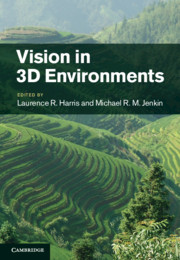Book contents
- Frontmatter
- Contents
- List of contributors
- 1 Seeing in three dimensions
- Part I Depth processing and stereopsis
- 2 Physiologically based models of binocular depth perception
- 3 The Influence of monocular regions on the binocular perception of spatial layout
- 4 Information, illusion, and constancy in telestereoscopic viewing
- 5 The role of disparity interactions in perception of the 3D environment
- 6 Blur and perceived depth
- 7 Neuronal interactions and their role in solving the stereo correspondence problem
- Part II Motion and navigation in 3D
- Part III Natural-scene perception
- Author Index
- Subject Index
4 - Information, illusion, and constancy in telestereoscopic viewing
from Part I - Depth processing and stereopsis
Published online by Cambridge University Press: 05 August 2011
- Frontmatter
- Contents
- List of contributors
- 1 Seeing in three dimensions
- Part I Depth processing and stereopsis
- 2 Physiologically based models of binocular depth perception
- 3 The Influence of monocular regions on the binocular perception of spatial layout
- 4 Information, illusion, and constancy in telestereoscopic viewing
- 5 The role of disparity interactions in perception of the 3D environment
- 6 Blur and perceived depth
- 7 Neuronal interactions and their role in solving the stereo correspondence problem
- Part II Motion and navigation in 3D
- Part III Natural-scene perception
- Author Index
- Subject Index
Summary
The concept of illusion
When is an illusion not an illusion? If the definition of an illusion is something like “a lack of correspondence between the ‘input’ and what we perceive,” then it necessarily depends on how we define the “input.” Clearly, this shouldn't refer to the characteristics of the proximal image, because if it did, we would have to treat all perceptual constancies as illusions since there is invariably a lack of correspondence between the retinal size, shape, or wavelength and what we see. Helmholtz (1910) was well aware of this when he wrote: “I am myself disposed to think that neither the size, form and position of the real retina nor the distortions of the image projected on it matter at all, as long as the image is sharply defined all over.” If the “input” is not to be defined in terms of the proximal image, then perhaps it should be defined in terms of the properties of the distal image – the real-world situation that creates a particular retinal input. This sounds better, but a problem arises when the patterns of light reaching the eyes have not been created by the real world but instead by some device that precisely mimics those patterns of light. For example, our perception of structure-from-motion that has been created by patterns of motion on a flat computer screen (a kinetic depth effect, or KDE) would have to regarded as an illusion, as would the perception of depth created by a pair of 2D images in a stereoscope.
Information
- Type
- Chapter
- Information
- Vision in 3D Environments , pp. 70 - 94Publisher: Cambridge University PressPrint publication year: 2011
Accessibility standard: Unknown
Why this information is here
This section outlines the accessibility features of this content - including support for screen readers, full keyboard navigation and high-contrast display options. This may not be relevant for you.Accessibility Information
- 3
- Cited by
